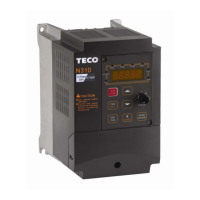Chapter 3 Ambient Environment and Installation
3-6
3.3.3 Precautions for peripheral applications:
Power supply:
z Make sure the correct voltage is applied to avoid
damaging the inverter.
z A molded-case circuit breaker or fused disconnect
must be installed between the AC source and the
inverter
Molded-case circuit breaker:
z Use a molded-case circuit breaker that conforms to the
rated voltage and current of the inverter to control the
power ON/OFF and protect the inverter.
z Do not use the circuit breaker as the run/stop switch
for the inverter.
Leakage breaker:
z Install a leakage breaker to prevent problems caused
by electric leakage and to protect personnel.
z Setting current should be 200mA or above and the
operating time at 0.1 second or longer to prevent
malfunctions.
Magnetic contactor:
z Normal operations do not need a magnetic contactor.
However a contactor has to be installed in primary
side when performing functions such as external
control and auto restart after power failure, or when
using a brake controller.
z Do not use the magnetic contactor as the run/stop
switch of the inverter.
AC reactor for power quality improvement:
z When inverters below 200V/400V class 15KW are
supplied with high capacity (above 600KVA) power
source or an AC reactor can be connected to improve
the power performance.
Install fast action fuse:
z To ensure the safety of peripheral devices, please
install fast action fuse. Regarding the specification,
please refer to P3-4.
Input noise filter:
z A filter must be installed when there are inductive
loads affecting the inverter
Inverter:
z Input power terminals L1, L2, and L3 can be used in
any sequence regardless of phase.
z Output terminals T1, T2, and T3 are connected to U,
V, and W terminals of the motor. If the motor is
reversed while the inverter is set to run forward, just
swap any two terminals of T1, T2, and T3.
z To avoid damaging the inverter, do not connect the
input terminals T1, T2, and T3 to AC input power.
z Connect the ground terminal properly. 200V class:
class 3 grounding, <100Ω; 400V class : <10Ω.
Figure 3-3 Typical Installation Schematic

